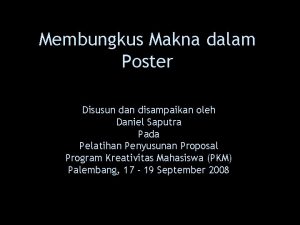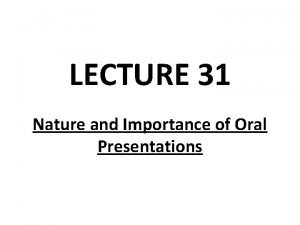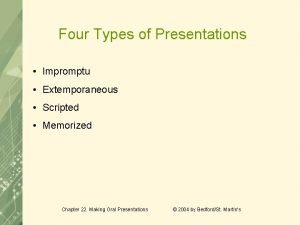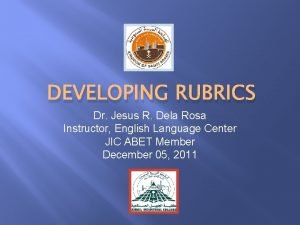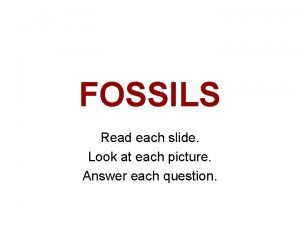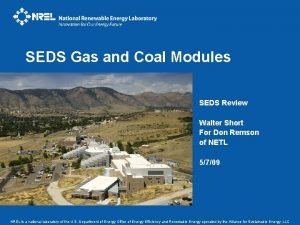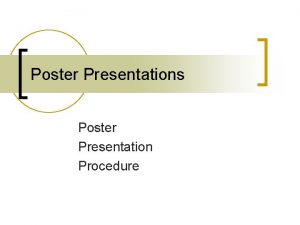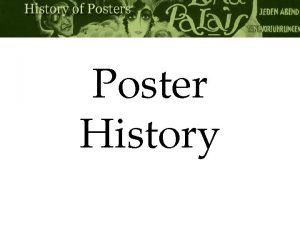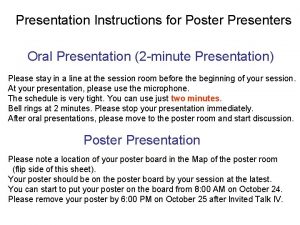An oral poster presentation Understanding the SEDs of



















- Slides: 19

An oral poster presentation: Understanding the SEDs of HAe. Be stars Joke Meijer University of Amsterdam Roy van Boekel, Michiel Min, Alex de Koter, Carsten Dominik, Kees Dullemond, Rens Waters Ringberg, April 2004

Overview of Talk • • Herbig stars Group I & II classification Aim of this study: what controls source being Group I or II Results and conclusions Ringberg, April 2004

Herbig Ae/Be stars • • More massive analogues of T Tauri stars Class II objects according to Lada classification Large IR excess due to thermal emission of CS dust Sites of on-going planet formation • IR energy distributions can be divided into two groups Ringberg, April 2004

Group I & II classification Based on ISO continua, SED may be represented by: Power-law + black body “flat” mid-IR Power-law strong decline towards far-IR Meeus et al. 2001 Ringberg, April 2004

Physical interpretation Group I & II Ringberg, April 2004

Comparison Group I & II SEDs Ringberg, April 2004

Group I & II in terms of IR colors Ringberg, April 2004 van Boekel et al. 2003

Definition of LNIR and LIR Ringberg, April 2004

Proposed mechanisms leading to (non-)flaring • Geometrically large or small disks – only way for DDN model to explain Group I & II (Dominik et al. 2002) – however, Group II cases observed to have disks much larger than required (Mannings & Sargent 1997) • Disks with puffed-up inner rim and self-shadowing – overal low disk mass, and/or concentrating mass in inner region leads to self-shadowing Group II – implying Group II sources have relatively low sub-mm emission – sub-mm flux may be increased by adding extra mass in form of midplane component of large grains, preserving Group II properties (Dullemond 2003, Dullemond & Dominik 2004) Ringberg, April 2004

Aim of this study • Extended parameter study, following Dullemond & Dominik (2004), to determine what controls Group I & II, studying – – – inclination mass distribution disk size dust composition • First quantitative comparison of models and observations, using color-color diagram Ringberg, April 2004

Passive disk model Dullemond & Dominik 2004 • 2 D axi-symmetric passive disk with prescribed surface density distribution (r) • Iterative procedure to obtain vertical hydrostatic structure, subject to 2 D radiative equilibrium • Dust consists of a homogeneous distribution of silicate & carbon grains, in different sizes, combined into a single opacity • Allows self-consistent treatment of self-shadowing effects Ringberg, April 2004

Investigated parameter space • Central star – Teff = 10, 000 K – R* = 3 Rsun – M* = 2 Msun • Disk – Mdisk = 10 -2. . 10 -4 Msun � r-p, where p = 1. . 2 – Rdisk = 200. . 600 AU Ringberg, April 2004

Effect of inclination Ringberg, April 2004

Effect of disk mass Ringberg, April 2004

Effect of surface density distribution Ringberg, April 2004

Effect of disk size Ringberg, April 2004

Full grid fails to reach Ib sources . . as no 10 micron feature implies low LIR, therefore high LNIR/LIR Ringberg, April 2004

Conclusions • Two order of magnitude change in mass of small grains can in itself explain Group I & II sources • Either (or both) Group II sources have – lower mass (sub-mm flux indicates up to factor 10) – component of large grains (> 1 mm) in which mass is “hidden” • Mass distribution, outer radius & inclination play a less important though non-negligible role • Group Ib sources (i. e. “flat” IR spectrum, no 10 m feature) are not reproduced by models • Current generation of 2 D models give fair match to observed stars in terms of IR colors, but not (yet) to detailed SED. Needed improvements include – more detailed dust composition – non-homogeneous dust distribution (growth & settling) Ringberg, April 2004

The End Ringberg, April 2004
 Perbedaan poster ilmiah dan poster umum
Perbedaan poster ilmiah dan poster umum Presentation techniques definition
Presentation techniques definition Interpersonal and intrapersonal skills ppt
Interpersonal and intrapersonal skills ppt Nature of oral presentation
Nature of oral presentation Intonation in an oral presentation
Intonation in an oral presentation Seminar presentation in english
Seminar presentation in english Designing and delivering oral and online presentations
Designing and delivering oral and online presentations Short english presentation
Short english presentation Oral presentation example
Oral presentation example Objectives of oral presentation
Objectives of oral presentation Iop
Iop Effective oral presentation techniques
Effective oral presentation techniques What is the major characteristic of an impromptu speech
What is the major characteristic of an impromptu speech Holistic rubric for oral presentation
Holistic rubric for oral presentation Tok presentation criteria
Tok presentation criteria Psc1 oral brevet
Psc1 oral brevet Look at the slide from an oral presentation about fossils
Look at the slide from an oral presentation about fossils Effective oral presentation techniques
Effective oral presentation techniques Effective oral presentation techniques
Effective oral presentation techniques Effective oral presentation techniques
Effective oral presentation techniques
